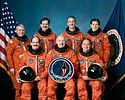STS-35
| Missionsemblem | |||||
|---|---|---|---|---|---|
 | |||||
| Missionsstatistik | |||||
| Missionsnavn: | STS-35 | ||||
| Rumagentur: | NASA | ||||
| Rumfærge: | Columbia (10) | ||||
| Antal besætningsmedlemmer: | 7 | ||||
| Affyringsrampe: | LC-39A (KSC) | ||||
| Opsendelse: | 2. december 1990 | ||||
| Landing: | 10. december 1990 | ||||
| Landet på: | Edwards Air Force Base | ||||
| Varighed: | 8 dage 23 timer | ||||
| Foto af besætningen | |||||
 | |||||
| Navigation | |||||
| |||||
STS-35 (Space Transportation System-35) var Columbias tiende rumfærge-mission. Opsendt 2. december 1990 og vendte tilbage den 10. december 1990.
Missionens hovedopgave var at foretage astronomiske observationer med ASTRO-1 platformen bestående af fire teleskoper: Hopkins Ultraviolet Telescope (HUT), Wisconsin Ultraviolet Photo-Polarimeter Experiment (WUPPE), Ultraviolet Imaging Telescope (UIT), og Broad Band X-Ray Telescope (BBXRT).
Hovedartikler:
Besætning

 Vance Brand (Kommandør)
Vance Brand (Kommandør)
 Guy Gardner (Pilot)
Guy Gardner (Pilot)
 Jeffrey Hoffman (Specialist)
Jeffrey Hoffman (Specialist)
 John Lounge (Specialist)
John Lounge (Specialist)
 Robert Parker (Specialist)
Robert Parker (Specialist)
 Samuel Durrance (Specialist)
Samuel Durrance (Specialist)
 Ronald Parise (Specialist)
Ronald Parise (Specialist)
Eksterne henvisninger
- STS-35 NASA (engelsk)
| ||||||||
Medier brugt på denne side
Forfatter/Opretter: Rei-artur (diskussion · bidrag), reshaped by F l a n k e r (talk), Licens: CC-BY-SA-3.0
symbol of Mars. 400 × 400 pixels nominal dimensions, line 45 pixel tick, circle 295 × 295 pixel, not joined with arrow. Colour: red=0 green=0 blue=140.
![]() Vektorgrafikken blev lavet med Inkscape.
Vektorgrafikken blev lavet med Inkscape.
The Astro-1 telescopes in Columbia's payload bay during the STS-35 mission.
During the STS-35 mission, the Astronomy Laboratory 1 (ASTRO-1) payload, in its onorbit operating configuration, is documented in the payload bay (PLB) of Columbia, Orbiter Vehicle (OV) 102. In the center of the frame, three ultraviolet telescopes are mounted and precisely coaligned on a common structure, called the cruciform, that is attached to the instrument pointing system (IPS). Visible on the cruciform are the Wisconsin Ultraviolet Photo-Polarimeter Experiment (WUPPE) (top left), the Hopkins Ultraviolet Telescope (HUT) (behind WUPPE), the Integrated Radiator System (IRS) (silver box on right), and the Optical Sensor Package (OSP) (above IRS). In the foreground and in front of the unpressurized spacelab pallet (U-pallet) is the igloo, a pressurized cylindrical container that houses the subsystems that provide such services as power, telemetry and commands to the instruments. On top of the vertical stabilizer (tail), the Shuttle Infrared Leeside Temperature Sensing (SILTS) system i
STS-35 Mission Insignia
This scene represents the end of NASA's STS-1 mission and the beginning of STS-2 in that the orbiter Columbia is arriving at Kennedy Space Center in Florida to begin the lengthy process of preparing it for STS-2. The vehicle landed at Dryden Flight Research Center on April 14 after an historic 2 1/3 day flight in Earth orbit. It was mated to this 747 aircraft, titled NASA 905, and flown over the USA to its Florida destination. It was later removed from atop NASA 905 and moved to the orbiter processing facility for the beginning of refurbishment.
The five astronauts and two payload specialists assigned to NASA's STS-35 mission, scheduled aboard Columbia, Orbiter Vehicle (OV) 102, in the spring of this year, pose for their crew portrait. Astronaut Vance D. Brand, center front and holding STS-35 insignia, making his fourth flight in space and his third STS flight, will serve as mission commander. he is flanked on the front row by Pilot Guy S. Gardner and Mission Specialist (MS) John M. Lounge. On the back row (left to right) are MS Robert A.R. Parker, Payload Specialist Ronald A. Parise, MS Jeffrey A. Hoffman, and Payload Specialist Samuel T. Durrance. The crewmembers are wearing their orange launch and entry suits (LESs).
Rare view shows two space shuttles on adjacent Kennedy Space Center (KSC) Launch Complex (LC) 39 pads with the Rotating Service Structures (RSS) retracted. STS-35 Columbia, Orbiter Vehicle (OV) 102, is on Pad A (foreground) and being readied for a September 6 early morning launch, while its sister spaceship, Discovery, OV-103, is prepared for an October liftoff on Mission STS-41. View provided by KSC with alternate number KSC-90PC-1268. Also see S90-48904 for a similar view with alternate KSC number KSC-90PC-1269.









